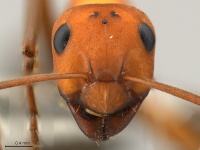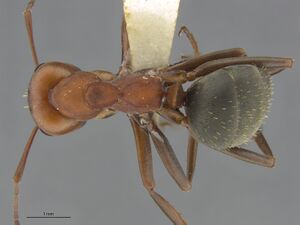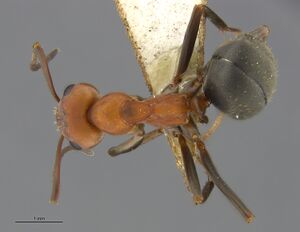Formica densiventris
| Formica densiventris | |
|---|---|

| |
| Scientific classification | |
| Kingdom: | Animalia |
| Phylum: | Arthropoda |
| Class: | Insecta |
| Order: | Hymenoptera |
| Family: | Formicidae |
| Subfamily: | Formicinae |
| Tribe: | Formicini |
| Genus: | Formica |
| Species group: | microgyna |
| Species: | F. densiventris |
| Binomial name | |
| Formica densiventris Viereck, 1903 | |
| Synonyms | |
| |
Nests are usually found under stones, but may be found in logs and stumps, and under bark, and may be composed entirely of thatching or only partially covered with thatching. The species occurs from prairies, including disturbed, weedy areas, to semiarid scrub up to pinyon-juniper, ponderosa pine-riparian, Douglas fir, and spruce-fir forests. Brood and reproductives have been found in nests in June to August. Workers are very aggressive when the nest is disturbed. Foragers tend aphids. This is one of the most common Formica species in northern New Mexico. It is known to enslave a range of Formica species.
| At a Glance | • Dulotic |
Identification
Distribution
Alberta, Canada and the western United States.
Latitudinal Distribution Pattern
Latitudinal Range: 53.991° to 19.022222°.
| North Temperate |
North Subtropical |
Tropical | South Subtropical |
South Temperate |
- Source: AntMaps
Distribution based on Regional Taxon Lists
Nearctic Region: Canada, United States (type locality).
Neotropical Region: Mexico.
Distribution based on AntMaps
Distribution based on AntWeb specimens
Check data from AntWeb
Countries Occupied
| Number of countries occupied by this species based on AntWiki Regional Taxon Lists. In general, fewer countries occupied indicates a narrower range, while more countries indicates a more widespread species. |

|
Habitat
In New Mexico (Mackay and Mackay 2002) - Prairies, including disturbed, weedy areas, to semiarid scrub up to pinyon-juniper, ponderosa pine-riparian, Douglas fir, and spruce-fir forests.
Biology
In New Mexico (Mackay and Mackay 2002): brood and reproductives were found in nests in June to August. A dealate female collected on 3 July 1986. Workers are very aggressive when the nest is disturbed. Foragers tend aphids. This is one of the most common Formica spp. in northern New Mexico.
Nevada, Wheeler and Wheeler (1986) - Our 24 records are from 16 localities, which are widely scattered throughout the state north of the Hot Desert; 5,500-10,000 ft. Five records are from the Pinyon-Juniper Biome, 6 from the Coniferous Forest Biome, and 1 is from the ecotone above it. Four nests were in and under rotten wood, 1 was under a stone, 1 was under a stone surmounted by thatch, and 1 was under a prostrate sagebrush trunk. When a populous nest was disturbed the workers moved rapidly and attacked promptly; the bite was annoying.
Slave Making
Formica pergandei is known to enslave the following species:
- Formica argentea
- Formica biophilica (doubtful, possible misidentification of host species)
- Formica neogagates
- Formica neorufibarbis
- Formica puberula
- Formica subaenescens (host given as Formica fusca, but likely Formica subaenescens, needs confirmation)
- Formica subpolita
- Formica subsericea (host possibly Formica podzolica, needs confirmation)
Association with Other Organisms
 Explore: Show all Associate data or Search these data. See also a list of all data tables or learn how data is managed.
Explore: Show all Associate data or Search these data. See also a list of all data tables or learn how data is managed.
- This species is a mutualist for the aphid Aphis lugentis (a trophobiont) (Jones, 1927; Saddiqui et al., 2019).
- This species is a mutualist for the aphid Obtusicauda frigidae (a trophobiont) (Jones, 1927; Saddiqui et al., 2019).
- This species is a prey for the Microdon fly Microdon manitobensis (a predator) (Quevillon, 2018).
Castes
Worker
       
| |
| . | Owned by Museum of Comparative Zoology. |
Images from AntWeb
   
| |
| Worker. Specimen code casent0102794. Photographer Jen Fogarty, uploaded by California Academy of Sciences. | Owned by CAS, San Francisco, CA, USA. |
   
| |
| Worker. Specimen code casent0005386. Photographer April Nobile, uploaded by California Academy of Sciences. | Owned by UCDC, Davis, CA, USA. |
Nomenclature
The following information is derived from Barry Bolton's Online Catalogue of the Ants of the World.
- densiventris. Formica fusca var. densiventris Viereck, 1903: 74 (w.) U.S.A. Cole, 1954a: 90 (m.). Junior synonym of subaenescens: Wheeler, W.M. 1913f: 504. Revived from synonymy as subspecies of fusca: Brown, 1947: 7. Raised to species: Creighton, 1950a: 499. Senior synonym of spicata: Cole, 1954a: 89; Cole, 1955b: 50; of rasilis: Mackay, Lowrie, et al. 1988: 114.
- rasilis. Formica microgyna var. rasilis Wheeler, W.M. 1903e: 648 (w.q.m.) U.S.A. Subspecies of microgyna: Wheeler, W.M. 1913f: 468. Raised to species: Creighton, 1950a: 506. Junior synonym of densiventris: Mackay, Lowrie, et al. 1988: 114.
- spicata. Formica rasilis subsp. spicata Creighton, 1950a: 507 (w.q.m.) U.S.A. [First available use of Formica microgyna subsp. rasilis var. spicata Wheeler, W.M. 1913f: 469; unavailable name.] Material of the unavailable name pinetorum referred here by Creighton, 1950a: 507. Junior synonym of densiventris: Cole, 1954a: 89; Cole, 1955b: 50.
Taxonomic Notes
The nomenclature and status of this ant have been very complicated. The description by Viereck (1903) is brief and completely inadequate, and based on two poorly preserved specimens (Brown, 1947). This has created considerable confusion. A number of species and subspecies have been synonymized with F. densiventris (Creighton, 1950; Cole, 1955b). Wheeler (1903c) described a taxon, F. rasilis based on workers, queens and males. Subsequently hybridization was observed between F. rasilis and F. densiventris (Creighton, 1950; Cole, 1955b; Gregg, 1963). Because of this, Gregg chose to consider F. densiventris as a subspecies of F. rasilis. We do not recognize a separate subspecies and due to precedence of date of publication (Viereck: Jan 1903; Wheeler: Nov 1903c) we consider the proper name of the species to be Formica densiventris Viereck (Mackay et al. 1988).
Description
References
- Borowiec, M.L., Cover, S.P., Rabeling, C. 2021. The evolution of social parasitism in Formica ants revealed by a global phylogeny. Proceedings of the National Academy of Sciences 118, e2026029118 (doi:10.1073/pnas.2026029118).
- Brown, W. L., Jr. 1947. A note upon two neglected species of Formica Linn. (Hym.: Formicidae). Entomol. News 58: 6-9 (page 7, Revived from synonymy as subspecies of fusca)
- Cole, A. C., Jr. 1942. The ants of Utah. Am. Midl. Nat. 28: 358-388.
- Cole, A. C., Jr. 1954a. Studies of New Mexico ants. VIII. A solution to the Formica densiventris Viereck problem (Hymenoptera: Formicidae). J. Tenn. Acad. Sci. 29: 89-90 (page 90, male described; page 89, Senior synonym of spicata)
- Cole, A. C., Jr. 1955b. Studies of New Mexico ants. XV. Additions, corrections, and new synonymy. J. Tenn. Acad. Sci. 30: 49-50 (page 50, Senior synonym of spicata)
- Creighton, W. S. 1950a. The ants of North America. Bulletin of the Museum of Comparative Zoology 104: 1-585 (page 499, Raised to species)
- Gregg, R. E. 1963. The ants of Colorado, with reference to their ecology, taxonomy, and geographic distribution. Boulder: University of Colorado Press, xvi + 792 pp.
- Mackay, W. P. and E. Mackay. 2002. The ants of New Mexico (Hymenoptera: Formicidae). Edwin Mellen Press, Lewiston, NY.
- Mackay, W. P.; Lowrie, D.; Fisher, A.; Mackay, E. E.; Barnes, F.; Lowrie, D. 1988. The ants of Los Alamos County, New Mexico (Hymenoptera: Formicidae). Pp. 79-131 in: Trager, J. C. (ed.) Advances in myrmecology. Leiden: E. J. Brill, xxvii + 551 pp. (page 114, Senior synonym of rasilis)
- Mallis, A. 1941. A list of the ants of California with notes on their habits and distribution. Bull. South. Calif. Acad. Sci. 40: 61–100.
- Viereck, H. L. 1903. Hymenoptera of Beulah, New Mexico. [part]. Trans. Am. Entomol. Soc. 29: 56-87 (page 74, worker described)
- Wheeler, G. C. and J. Wheeler. 1986. The ants of Nevada. Natural History Museum of Los Angeles County, Los Angeles.
- Wheeler, W. M. 1913i. A revision of the ants of the genus Formica (Linné) Mayr. Bulletin of the Museum of Comparative Zoology 53: 379-565 (page 504, Junior synonym of subaenescens)
References based on Global Ant Biodiversity Informatics
- Allred D. M. 1982. Ants of Utah. The Great Basin Naturalist 42: 415-511.
- Allred, D.M. 1982. The ants of Utah. Great Basin Naturalist 42:415-511.
- Bestelmeyer B. T., and J. A. Wiens. 2001. Local and regional-scale responses of ant diversity to a semiarid biome transition. Ecography 24: 381-392.
- Browne J. T., R. E. Gregg. 1969. A study of the ecological distribution of ants in Gregory Canyon, Boulder, Colorado. University of Colorado Studies. Series in Biology 30: 1-48
- Cole A. C., Jr. 1942. The ants of Utah. American Midland Naturalist 28: 358-388.
- Cole A. C., Jr. 1956. Studies of Nevada ants. III. The status of Formica nevadensis Wheeler (Hymenoptera: Formicidae). Journal of the Tennessee Academy of Science 31: 256-257.
- Field Museum Collection, Chicago, Illinois (C. Moreau)
- Francoeur A. 2010. Liste des especes de fourmis (Formicides, Hymenopteres). Entomofaune du Quebec. Document Faunique no. 1, Version 5, 0. 1-10 pp.
- Glasier J. R. N., S. E. Nielsen, J. Acorn, and J. Pinzon. 2019. Boreal sand hills are areas of high diversity for Boreal ants (Hymenoptera: Formicidae). Diversity 11, 22; doi:10.3390/d11020022.
- Glasier J. R. N., S. Nielsen, J. H. Acorn, L. H. Borysenko, and T. Radtke. 2016. A checklist of ants (Hymenoptera: Formicidae) of Saskatchewan. The Canadian Field-Naturalist 130(1): 40-48.
- Glesne R. S. 2000. Terrestrial riparian arthropod investigations in the Big Beaver Creek Research Natural Area, North Cascades National Park Service Complex, 1995-1996: Part IV, Hymenoptera: Formicidae. 48 pages
- Gregg, R.T. 1963. The Ants of Colorado.
- Johnson R. Personnal Database. Accessed on February 5th 2014 at http://www.asu.edu/clas/sirgtools/resources.htm
- La Rivers I. 1968. A first listing of the ants of Nevada. Biological Society of Nevada, Occasional Papers 17: 1-12.
- Longino, J.T. 2010. Personal Communication. Longino Collection Database
- MacKay W. P. 1993. Succession of ant species (Hymenoptera: Formicidae) on low-level nuclear waste sites in northern New Mexico. Sociobiology 23: 1-11.
- Mackay W. P., and E. E. Mackay. 2002. The ants of New Mexico (Hymenoptera: Formicidae). Lewiston, New York: Edwin Mellen Press, 400 pp.
- Mackay, W., D. Lowrie, A. Fisher, E. Mackay, F. Barnes and D. Lowrie. 1988. The ants of Los Alamos County, New Mexico (Hymenoptera: Formicidae). pages 79-131 in J.C. Trager, editor, Advances in Myrmecololgy.
- Quiroz Robledo L. N., and J. E. Valenzuela Gonzalez. 1993. Contribucion al conocimiento de la mirmecofauna del estado de Hidalgo, Mexico (Hymenoptera: Formicidae). En: Villavicencio-Nieto (ed) Flora y Fauna del Estado de Hidalgo. Universidad Autónoma de Hidalgo. p. 340-393. ISBN 968-63 40-36-X
- Rees D. M., and A. W. Grundmann. 1940. A preliminary list of the ants of Utah. Bulletin of the University of Utah, 31(5): 1-12.
- Siddiqui, J. A., Li, J., Zou, X., Bodlah, I., Huang, X. 2019. Meta-analysis of the global diversity and spatial patterns of aphid-ant mutualistic relationships. Applied Ecology and Environmental Research 17: 5471-5524 (doi:10.15666/aeer/1703_54715524).
- Vásquez-Bolaños M. 2011. Lista de especies de hormigas (Hymenoptera: Formicidae) para México. Dugesiana 18: 95-133
- Wesson L. G., and R. G. Wesson. 1940. A collection of ants from southcentral Ohio. American Midland Naturalist 24: 89-103.
- Wheeler G. C., and J. Wheeler. 1986. The ants of Nevada. Los Angeles: Natural History Museum of Los Angeles County, vii + 138 pp.
- Wheeler J. N., G. C. Wheeler, R. J. Lavigne, T. A. Christiansen, and D. E. Wheeler. 2014. The ants of Yellowstone National Park. Lexington, Ky. : CreateSpace Independent Publishing Platform, 2013. 112 pages.
- Wheeler W. M. 1913. A revision of the ants of the genus Formica (Linné) Mayr. Bulletin of the Museum of Comparative Zoology 53: 379-565.
- Wheeler W. M. 1917. The mountain ants of western North America. Proceedings of the American Academy of Arts and Sciences 52: 457-569.
- Wheeler, G.C. and J. Wheeler. 1978. Mountain ants of Nevada. Great Basin Naturalist 35(4):379-396
- Wheeler, G.C. and J. Wheeler. 1988. A checklist of the ants of Wyoming. Insecta Mundi 2(3&4):230-239
- Yensen N. P., W. H. Clark, and A. Francoeur. 1977. A checklist of Idaho ants (Hymenoptera: Formicidae). Pan-Pacific Entomologist 53: 181-187
- Pages using DynamicPageList3 parser function
- Dulotic
- Need species key
- North temperate
- North subtropical
- Tropical
- Ant Associate
- Host of Formica argentea
- Host of Formica biophilica
- Host of Formica neogagates
- Host of Formica neorufibarbis
- Host of Formica puberula
- Host of Formica subaenescens
- Host of Formica subpolita
- Host of Formica subsericea
- Aphid Associate
- Host of Aphis lugentis
- Host of Obtusicauda frigidae
- ''Microdon'' fly Associate
- Host of Microdon manitobensis
- Species
- Extant species
- Formicidae
- Formicinae
- Formicini
- Formica
- Formica densiventris
- Formicinae species
- Formicini species
- Formica species
- Need Body Text
- Microgyna group

